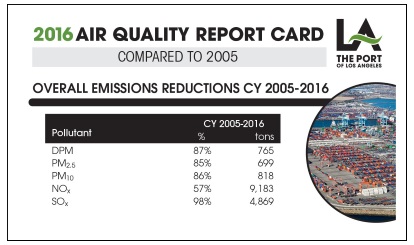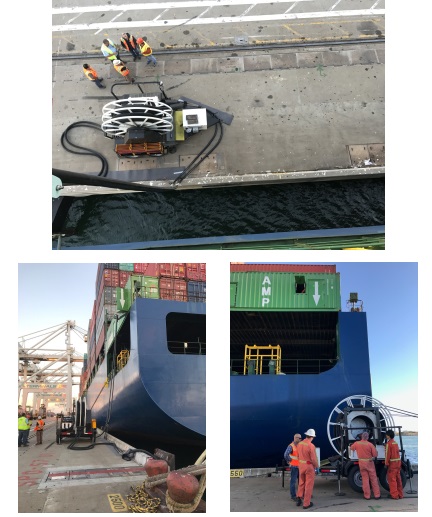Environment: Los Angeles, Oakland
Emissions Plunge, Cargo Soars at Port of Los Angeles
The Port of Los Angeles achieved record clean air gains while moving more cargo than ever, according to the port’s 2016 Inventory of Air Emissions. The annual report also shows the port surpassed its 2020 goal for reducing the health risk of emissions from port-related activity.

Calendar year 2016 marked the port’s greatest reduction of all key pollutants. Since the port’s baseline inventory in 2005, diesel particulate matter (DPM) emissions have fallen by 87 percent, sulfur oxides (SOx) emissions by 98 percent, and nitrogen oxide (NOx) emissions by 57 percent.
During the same period, the port moved more than 8.85 million container TEUs, surpassing the earlier record of nearly 8.47 million TEUs set in 2006. The 2016 peak represents an 18 percent increase in cargo since the 2005 baseline inventory.
DPM emissions are also used to assess health risk. The port met its 2020 goal in 2014 by lowering DPM emissions by 85 percent. With an 87 percent reduction in health risk in 2016, the port continues to exceed its 2020 goal.
A closer look at the numbers reveals the extent of port’s air quality improvement gains. From 2015 to 2016 alone, the data shows pollutant declines of 13 percent for DPM, 10 percent for NOx and 14 percent for SO
For every 10,000 TEUs handled at the port complex, DPM emissions fell 89 percent, NO 63 percent, and SO 98 percent. Greenhouse gas emissions (GHGs) were at their lowest – down 28 percent per 10,000 TEUs.
The latest findings are based on data collected during calendar year 2016 and reviewed by regional, state and federal air regulatory agencies. The inventory is a detailed report card documenting the impact of all strategies for curbing every source of port-related emissions: ships, locomotives, trucks, cargo handling equipment and harbor craft.
Full implementation of the port’s strategies under the San Pedro Bay Ports Clean Air Action Plan (CAAP), compliance with government air quality regulations, and improved operational efficiencies worked in concert to achieve the 2016 gains. Operational efficiencies include a chassis pool serving the entire complex, advanced planning for the largest ship calls, and additional measures that vessel operators, terminals, railroads, trucking companies and other port partners collaborated on and adopted to prevent the congestion that slowed cargo during late 2014 and early 2015.
Substantial progress in reducing emissions from ships played a key role in the 2016 results. Factors include the ongoing trend of fewer vessel calls due to bigger ships carrying more cargo, fleet compliance with California’s shore power regulations for an entire year without congestion, and an increased use of alternative emissions capture technology when plugging into shore-side electricity is unavailable.
Increased compliance with cleaner vessel fuel regulations, continued participation in the Port’s Vessel Speed Reduction Program, and growing participation in the port’s voluntary Environmental Ship Index program also led to clean air progress. The latter offers incentives that encourage vessel operators to bring their cleanest ships to Los Angeles and demonstrate new onboard pollution reduction technology.
Going forward, the port is pursuing new clean air measures while cargo throughput continues to rise. The port is continuing its focus on reducing health risk and criteria pollutant emissions, especially NOx, while increasing efforts to reduce GHGs. To accomplish this, the port is working with its industry partners to implement near-zero and zero tailpipe emissions strategies. These include expanding demonstration projects to test zero emissions drayage trucks and launching new projects to test near-zero and zero emission yard tractors and zero emissions top handlers for which the port has secured funding from the California Air Resources Board and the California Energy Commission.
The increased emphasis on GHG is reflected in the proposed 2017 CAAP Update, which sets new targets for reducing GHG emissions 40 percent below 1990 levels by 2030 and 80 percent below 1990 levels by 2050. A joint document of the ports of Los Angeles and Long Beach, the 2017 CAAP is available at http://www.cleanairactionplan.org for public review and comment through Sept. 18. Commissioners from both ports are slated to hold a joint meeting to consider the final version in November.
Port of Oakland OKs New High-Power Line to Plug in More Ships
In another step aimed at curbing diesel emissions from ships, the Port of Oakland has approved a high-voltage cable system that will connect more vessels to the port’s landside power grid. The action accelerates a program that has helped cut emissions at the port by 76 percent since 2009.
The 200-foot cable-on-reel system will be deployed at Oakland International Container Terminal where it will connect to ships that cannot closely align with landside electrical vaults at berth. Once plugged into the vaults, the ships will switch off on-board diesel engines and rely on grid power, dropping diesel emissions to zero during their Oakland calls.
Nearly 400 vessels are equipped to plug into Oakland’s landside electrical system but sometimes they berth beyond the reach of their on-board power cables.
That’s where the terminal’s new $230,000 cable system comes in. The10-foot-tall reel is affixed to a trailer and can be deployed alongside any vessel. The cable will connect ships to one of the marine terminal’s 18 shore power electrical vaults.
Port engineers have overseen two successful trials of the mobile cable system, which is expected to be deployed full-time by autumn.

Mobile cable on-wheel unit allows ships to plug in to shoreside power wherever berthed
Photo/Port of Oakland


